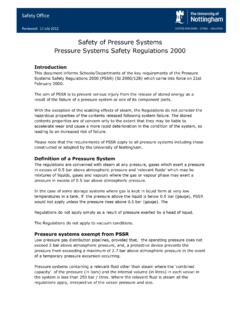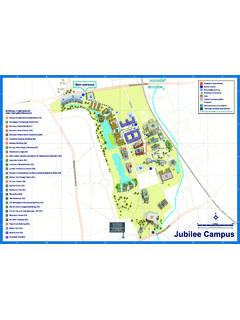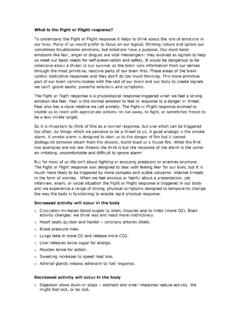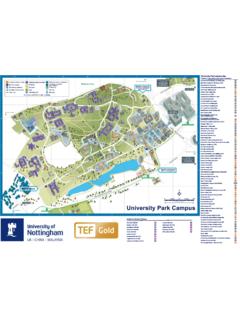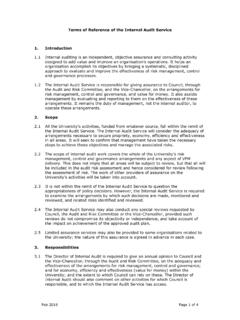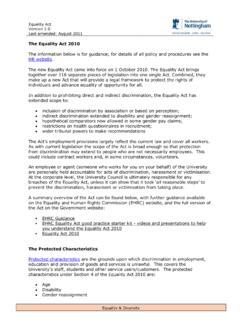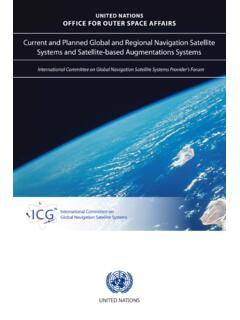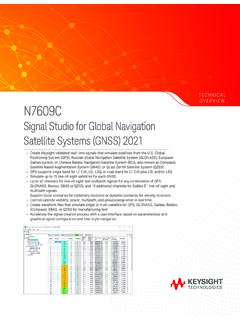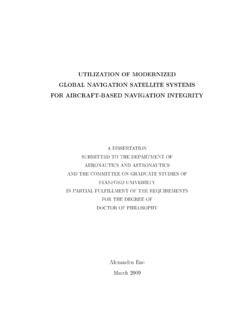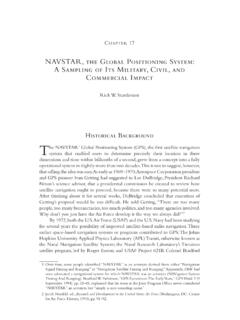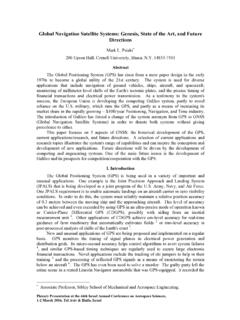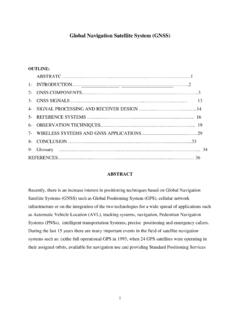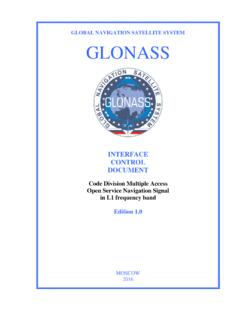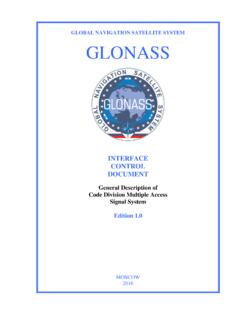Transcription of 1. LOBAL NAVIGATION SATELLITE SYSTEMS
1 1 1. global NAVIGATION SATELLITE SYSTEMS The global NAVIGATION SATELLITE system (GNSS) is a constellation of satellites, transmitting signals for use in NAVIGATION and positioning applications, anywhere on the surface of the earth. There are currently two global NAVIGATION SATELLITE SYSTEMS in operation: the global Positioning system (GPS) and the Russian global NAVIGATION SATELLITE system (GLONASS). A third system , Galileo, is currently under development in Europe. Galileo will provide a wide range of positioning signals and services including the high-reliability service required by safety-of-life-critical applications. Galileo will also provide a high level of integrity on the global scale and without any additional augmentation system . All the three SYSTEMS will be interoperable. Combined use of Galileo and GPS will provide unprecedented increase in the availability of positioning.
2 Another name for GPS ( global Positioning system ) given by its owner, the Department of Defense, is NAVSTAR ( NAVIGATION SATELLITE Timing and Ranging). GPS is a SATELLITE based NAVIGATION system , operational since late 1995. Its constellation consists out of 24 satellites, which transmit ranging signals and NAVIGATION data 24 hours a day free of charge. GPS receivers obtain their locations on earth by measuring the distance from the satellites and computing their position relative to the Earth-fixed coordinate frame, WGS-84. GPS is funded and controlled by the Department of Defense (DoD) and was originally intended for military applications. In the 1980s, the government made the GPS system available for civilian use. It was the first system widely available to civilian users. The Russian global NAVIGATION SATELLITE system GLONASS is similar in operation as GPS and may prove complimentary to the NAVSTAR system .
3 Launched in 1996, its constellation is orbiting 19,100 Km above the earth in three orbital planes. The development of the European GNSS system , GALILEO, began in 1999. It is scheduled to be fully operational in 2012. In its full constellation, Galileo will consist of 30 satellites, continuously transmitting high-frequency ranging signals, containing time and distance data tracked by a Galileo receiver. The future Galileo satellites will transmit a variety of signals modulated on four different carriers: E5a, E5b, E6 and L1. New signal processing techniques are required in order to track Galileo signals due to the new modulation types BOC and AltBOC and the presence of Pilot and Data channels at all frequencies. Galileo will provide a wide range of services including open, safety-of-life, commercial, and publicly regulated service.
4 Galileo will guarantee the reliability of its signal anywhere on earth. 2 2. WHAT IS GPS? HOW DOES IT WORK? The global Positioning system (GPS) is a worldwide radio- NAVIGATION system formed from a constellation of 24 satellites and their ground stations. The basic GPS then uses satellites within the constellation as reference points to calculate positions accurate to a matter of meters. The GPS satellites transmit low power radio signals on multiple frequencies. L1 and L2 are the two basic carrier frequencies that contain the NAVIGATION signals. The L1 frequency is MHz in the UHF band while the L2 frequency is MHz. The signals travel by line of sight (the signal passes through clouds, glass, plastic and other lightweight materials but does not go through buildings, mountains or other enclosed spaces). The L1 signal contains two pseudorandom signals: the P (Protected) code and the C/A (Coarse/Acquisition) code.
5 A receiver can identify the signals because each GPS SATELLITE transmits a unique code. The P code can be scrambled to prevent unauthorised access (=Anti-spoofing), it is then referred to as P(Y) code or Y code. A GPS signal contains a pseudorandom code, ephemeris data and almanac data. The first code identifies the SATELLITE that is transmitting information. Ephemeris data contains information about the status of the SATELLITE (healthy or unhealthy), current date and time. The almanac data informs the receiver where each GPS receiver should be at any time throughout the day. Three satellites are used to triangulate a position (longitude, latitude and height), and a fourth SATELLITE needs to be in line of sight in order to calculate time. The more satellites in view, the more accurate the positioning will be. 3 3.
6 TRIANGULATING FROM SATELLITES The calculation of a location on earth relies on the GPS receiver accurately measuring its distance from four or more of the GPS satellites. In the first instance, if the distance from a GPS SATELLITE to a GPS receiver was measured at 18,000km, the possible locations of the receiver is somewhere on the surface of a sphere that has a radius of 18,000km. If the measured distance from the receiver to a second SATELLITE was 20,000km, the possible location of the GPS receiver is its position on the first sphere and on a sphere with a radius of 20,000km, within an area where the spheres intersect. If the measured distance to a third SATELLITE was 15,000km, the only possible locations for the GPS receiver is one of two points where the sphere of radius 15,000km cuts through the intersection of the first two spheres. Although in theory no further satellites are required (as one of the triangulated points will have its location somewhere in space, not on the earth s surface) a fourth SATELLITE is required in practice, and each additional SATELLITE acquired by the GPS receiver increases the accuracy of the positioning.
7 18,000km 4 4. HOW THE DISTANCES TO SATELLITES ARE MEASURED The distance from the GPS receiver to each of the GPS satellites relies on accurately measuring the time taken for a radio signal transmitted by a SATELLITE to reach the receiver on earth, : The fact that GPS signals travel at the speed of light presents two problems: Firstly, the times measured are going to be very short, if a SATELLITE were directly over-head a receiver, the travel time of the signal would be ~ seconds. Secondly, to accurately measure these times requires very accurate clocks; (a GPS SATELLITE is equipped with two atomic clocks but these are prohibitively expensive for use in hand-held receivers). To overcome this each GPS SATELLITE transmits its own individual pseudo-random code and two other pieces of information: GPS Almanac This is a data file that contains orbit information on all satellites, clock corrections, and atmospheric delay parameters.
8 Each GPS SATELLITE transmits this information to a GPS receiver, thereby facilitating rapid SATELLITE vehicle acquisition within GPS receivers. Ephemeris - The ephemeris contains predictions of the current SATELLITE position. In addition, the GPS receiver transmits the same pseudo-random codes as the GPS satellites; however, as the satellites signals have to travel through space, they experience a slight delay when compared to those generated by the receiver. The receiver therefore delays its pseudo-random codes until they fell into synchronisation with those of the satellites. The amount by which signal is delayed is therefore equal to the travel time of the satellites versions. Velocity Time = Distance GPS radio signals travel at the speed of light 300,000km/s. 5 5. GETTING PERFECT TIMING As the location of the GPS receiver is determined by the measured time taken by a signal transmitted by a GPS SATELLITE to reach that receiver, it is essential that the timing is accurate.
9 However, although the clocks on board GPS satellites giving them almost perfect timing, the clocks on GPS receivers are no more than the quartz devices found in wristwatches. As both the SATELLITE and the receiver need to precisely synchronise their pseudo-random codes to make the system work, a discrepancy of just 1/1000th of a second between them would result in a positional error of >320km. To overcome the limitations of the GPS receiver s imperfect clock, the GPS receiver takes the measurements from three satellites to calculate its position. It then takes a measurement from a fourth SATELLITE as a cross check, as this position will NOT intersect with the first three, the receiver detects a discrepancy in its measurements. The receiver then recognises that its clock is not synchronised to universal time. The receiver therefore looks for a single correction factor that it can subtract from all its timing measurements that would cause them all to intersect at a single point.
10 That correction brings the receiver's clock back into sync with universal time providing atomic clock accuracy. Once the receiver applies that correction to the signals received from all the satellites in view, precise positioning becomes possible. One consequence of this principle is that any decent GPS receiver will need to have at least four channels so that it can make the four measurements simultaneously. 6 6. THE QUEST FOR GREATER ACCURACY The quest for greater and greater accuracy has now spawned an assortment of variations on basic GPS technology. One technique, called "Differential GPS," involves the use of two ground-based receivers. One monitors variations in the GPS signal and communicates those variations to the other receiver. The second receiver then corrects its calculations for better accuracy. Another technique called "Carrier-phase GPS" takes advantage of the GPS signal's carrier signal to improve accuracy.
